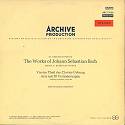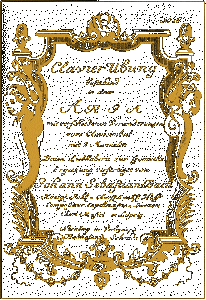| BWV 988 · The Goldberg Variations in G Major |
 |
|
|
|
 |
|
Instrumentation:
|
Harpsichord with two manuals
|
|
|
 |
|
|
Theme. |
Aria
|
|
Variatio 1. |
a 1 Clav.
|
|
Variatio 2. |
a 1 Clav.
|
|
Variatio 3. |
a 1 Clav. Canone all'Unisono
|
|
Variatio 4. |
a 1 Clav.
|
|
Variatio 5. |
a 1 ovvero 2 Clav.
|
|
Variatio 6. |
a 1 Clav. Canone alla Seconda
|
|
Variatio 7. |
a 1 ovvero 2 Clav. al tempo di Giga
|
|
Variatio 8. |
a 2 Clav.
|
|
Variatio 9. |
a 1 Clav. Canone alla Terza
|
|
Variatio 10. |
a 1 Clav. Fughetta
|
|
Variatio 11. |
a 2 Clav.
|
|
Variatio 12. |
(a 1 Clav.) Canone alla Quarta
|
|
Variatio 13. |
a 2 Clav.
|
|
Variatio 14. |
a 2 Clav.
|
|
Variatio 15. |
a 1 Clav. Canone alla Quinta Andante (G minor)
|
|
Variatio 16. |
a 1 Clav. Ouverture
French Overture and Fugue
|
|
Variatio 17. |
a 2 Clav.
|
|
Variatio 18. |
a 1 Clav. Canone alla Sesta
|
|
Variatio 19. |
a 1 Clav.
|
|
Variatio 20. |
a 2 Clav.
|
|
Variatio 21. |
(a 1 Clav.) Canone alla Settima (G minor)
|
|
Variatio 22. |
a 1 Clav. Alla breve
|
|
Variatio 23. |
a 2 Clav.
|
|
Variatio 24. |
a 1 Clav. Canone all'Ottava
|
|
Variatio 25. |
a 2 Clav. adagio (G minor)
|
|
Variatio 26. |
a 2 Clav.
|
|
Variatio 27. |
a 2 Clav. Canone alla Nona
|
|
Variatio 28. |
a 2 Clav.
|
|
Variatio 29. |
a 1 ovvero 2 Clav.
|
|
Variatio 30. |
a 1 Clav. Quodlibet
|
|
|
Aria da Capo
|
|
 |
|
References:
|
|
|
 |
|
  |
Johann Sebastian Bach:

Vierter Theil der Clavier-Uebung:
Goldberg-Variations, BWV 988

Liner-Notes by Ralph Kirkpatrick
from his classic 1958 recording on Archive Production
|
|
|
 |
 The "Goldberg" Variations were first published in 1742 by Balthasar Schmid in Nürnberg under the modest title: "Keyboard-practice, consisting of an Aria with different variations for the harpsichord with two manuals. Prepared for the enjoyment of music-lovers by Johann Sebastian Bach, Polish royal and Saxon electoral court-composer, director and choir-master in Leipzig.' The Aria appears as a Sarabande in Anna Magdalena Bach's note-book of the year 1725.
The "Goldberg" Variations were first published in 1742 by Balthasar Schmid in Nürnberg under the modest title: "Keyboard-practice, consisting of an Aria with different variations for the harpsichord with two manuals. Prepared for the enjoyment of music-lovers by Johann Sebastian Bach, Polish royal and Saxon electoral court-composer, director and choir-master in Leipzig.' The Aria appears as a Sarabande in Anna Magdalena Bach's note-book of the year 1725.
About the composition of these variations, Forkel 1) tells the following story, which, for all its doubtful character, has permanently attached to them the name of Bach's pupil, Johann Gottlieb Goldberg.
"For this model, upon which all sets of variations should be formed (although for comprehensible reasons not a single set has yet been thus made), we have to thank the instigation of the former Russian ambassador to the electoral court of Saxony, Count Keyserlingk, who often stopped in Leipzig and brought there with him the aforementioned Goldberg, in order to have him given musical instruction by Bach. The Count was often ill an a sleepless nights. At such times, Goldberg, who lived in his house, had to spend the night in an antechamber, so as to play for him during his insomnia. Once the Count mentioned in Bach's presence that he would like to have some clavier pieces for Goldberg, which should be of such a smooth and somewhat lively character that he might be a little cheered up by them in his sleepless nights. Bach thought himself best able to fulfill this wish by means of variations, the writing of which he had until then considered an ungrateful task on account of the repeatedly similar harmonic foundation.
Thereafter the Count always called them his variations. He never was tired of them, and for a long time during sleepless nights he meant: 'Dear Goldberg, do play me one of my variations.' Bach was perhaps never so rewarded for one of his works as for this. The Count presented him with a golden goblet filled with 100 louis-d'or. Nevertheless, even had the gift been a thousand times larger, their artistic value would not yet have been paid for."
Like an enormous passacaglia, these variations reiterate the harmonic implications of the same bass in thirty different forms. This fundamental bass is never stated entirely in its most elemental form not even in the Aria. But on this harmonic skeleton and around it are constructed the variations, each highly organized and composed of independent thematic material. These follow one another in a symmetrical grouping like the beads of a rosary.
The form of the variations as a whole may be shown by comparison, as before, to that of a rosary, or perhaps better explained by an architectural analogy; Framed as if between two terminal pylons, one formed by the Aria and the first two variations, the other by the two penultimate variations and the Quodlibet, the variations are grouped like the members of an elaborate colonnade. The groups are composed of a canon and' an elaborate two-manual arabesque, enclosing in each case another variation of independent character. Following upon the pylon-like group which terminates this rhythmic procession, the Aria repeated closes the great circle.
There are nine canons, at intervals successively from the unison to the ninth, those at the fourth and fifth in contrary motion, that at the ninth without any independent third voice, such as accompanies the others. Among the variable forms are to be found a fughetta, a French overture, florid slow movements, etc.
The Quodlibet mixes together the tunes of two folk-songs:
"Ich bin so lang nicht bei dir g'west.
Ruck her, ruck her, ruck her."
and:
"Kraut und Räben haben mich vertrieben,
hätt' mein' Mutter Fleisch gekocht,
so wär' ich länger blieben."
These might be translated thus:
"I've not been with you for so long.
Come closer, closer, closer."
and:
"Beets and spinach drove me far away.
Had my mother cooked some meat,
then I'd have stayed much longer."
The following passage from the preface to my edition of the Goldberg Variations, published by G. Schirmer, New York, represents a kind of writing which I feel should not ordinarily be indulged. It was written nearly twenty-five years before the making of the present recording. Yet in the intervening time, despite modifications in the interpretation of a few variations, my sentiments have not fundamentally changed.
"However much it is an act of impudence thus to discuss something which is far too profound and complex to be grasped in words, it seems necessary to confess some of the feelings which inevitably come with the playing of this music.
The Aria seems to foreshadow the spirit of the whole work through the tenderness and calm with which the solemnity of the fundamental bass is clothed at its initial appearance.
The first variation stands like a festive gateway leading to the inner world exposed in the following three variations. These, like so many of the canons and the Aria, have an unearthly pure sweetness and a lyricism in every phrase that makes one long to dissolve one's fingers, the instrument, and one's whole self into three or four singing voices. For a moment this quiet lyricism is interrupted by the shining smooth swiftness of the first arabesque variation (5). Then comes a second canon of an almost nostalgic tenderness; then a faraway scherzo (7) of the utmost lightness and delicacy. The following arabesque and canon return to a lyricism which is interrupted by the brusque roughness of the Fughetta (10). This is followed by the delicate network of the third arabesque and the sunny canon at the fourth. Then comes a flute aria (13) of a breath-taking quiet pure joy. The humour of the fourth arabesque makes even more striking the appearance of the dark tragic canon at the fifth which ends the first half of the variations.
The second half opens with a majestic French Overture (16), followed by one of the lightest of the arabesque variations. In the sixth canon and the lute-variation (19) we return to a lyric sweetness like that of the beginning, even more peaceful. Another scherzo arabesque contrasts with the sombre seventh canon, which in turn joins on to the alla breve variation (22). This, for all its quicker tempo, transforms the chromatic pathos of the canon into that kind of serene chastened joy which follows pain. In the seventh arabesque we burst forth in the most unrestrained exuberant joy, which is tranquilized in the gentle rocking of the canon at the octave. Again we are interrupted to be carried to even greater tragic heights on the waves of a quiet yet irresistibly passionate aria. From the eighth arabesque (26) on, the variations mount through a sprightly canon, glittering trills (28), and waltz-like bravura (29) to the final jubilant climax in the Quodlibet (30), upon which the repetition of the Aria falls like a benediction,
But for all their lyricism and tragic passion and exuberance, the Aria and the Variations seem of a divine substance entirely refined and purified of anything personal or ignoble, so that in playing them one seems only the unworthy mouthpiece of a higher voice.
But how Bach himself in pious humility would ridicule these high-sounding words of ours with a wry face and with god-like laughter:
'Kraut und Rüben...'" Ralph Kirkpatrick
1) Uber Johann Sebastian Bachs Leben, Kunst und Kunstwerke, IX (1802).
|
|
|
|

|

|

|
|